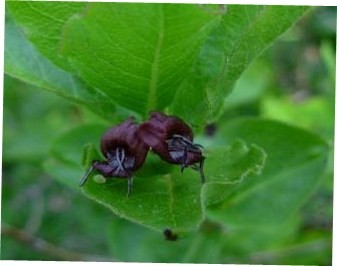Purpleflower honeysuckle
(Lonicera conjugialis)

Description
Lonicera conjugialis is a species of honeysuckle known by the common name purpleflower honeysuckle. It is native to the western United States from Pacific Northwest to the Sierra Nevada, where it grows in many types of mountain habitat, especially moist areas. This is a slender shrub often exceeding 1.5 meters in erect height. The lightly hairy leaves are oval to round and 2 to 8 centimeters long. The inflorescence is generally a pair of flowers nestled in a leaf axil toward the end of a branch. Each flower is maroon red to deep purple in color. It has an upper lip made up of four fused lobes, and a single-lobed lower lip. The protruding stamens are tipped with light-colored anthers. The fruit is a pair of bright red berries which are often fused together in a double-lobed unit. Honeysuckles are arching shrubs or twining vines in the family Caprifoliaceae, native to northern latitudes in North America and Eurasia. Approximately 180 species of honeysuckle have been identified in North America and Eurasia. Widely known species include Lonicera periclymenum (common honeysuckle or woodbine), Lonicera japonica (Japanese honeysuckle, white honeysuckle, or Chinese honeysuckle) and Lonicera sempervirens (coral honeysuckle, trumpet honeysuckle, or woodbine honeysuckle). L. japonica is an aggressive, highly invasive species considered a significant pest on the continents of North America, Europe, South America, Australia, and Africa. Some species are highly fragrant and colorful, so are cultivated as ornamental garden plants. In North America, hummingbirds are attracted to the flowers, especially L. sempervirens and L. ciliosa (orange honeysuckle). Honeysuckle derives its name from the edible sweet nectar obtainable from its tubular flowers. The name Lonicera stems from Adam Lonicer, a Renaissance botanist. Most species of Lonicera are hardy twining climbers, with a minority of shrubby habit. Some species (including Lonicera hildebrandiana from the Himalayan foothills and L. etrusca from the Mediterranean) are tender and can only be grown outside in subtropical zones. The leaves are opposite, simple oval, 1–10 cm long; most are deciduous but some are evergreen. Many of the species have sweetly scented, bilaterally symmetrical flowers that produce a sweet, edible nectar, and most flowers are borne in clusters of two (leading to the common name of "twinberry" for certain North American species).
Taxonomic tree:







